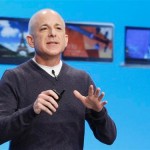Microsoft’s Next Cheif Executive Resigns
Just two weeks after launching the flagship Windows 8, the executive most widely speculated to be the next chief executive of Microsoft Corp has left the world's largest software maker as CEO Steve Ballmer moved to tighten his grip on the company.
The exit of 23-year veteran Steven Sinofsky, head of Microsoft's Windows unit, is the latest and one of the most prominent - in a line of high-profile departures from the Redmond, Washington-based company, which is struggling to keep pace with Apple Inc and Google Inc in mobile computing.
It comes hard on the heels of Sinofsky presenting the most radical restoration of Windows since 1995, designed to project Microsoft back into the forefront of Internet-based, touch-screen technology and revive a stock price that has been static for the past decade.
The move was unexpected and neither Microsoft nor Sinofsky gave an explanation, although an executive at the company, who requested not to be named, said the decision was "mutual" and said he was not expecting Sinofsky to take a job at another company soon.
"This is shocking news. This is very surprising," said Brendan Barnicle, an analyst at Pacific Crest Securities. "Like a lot of people, I thought Sinofsky was in line to potentially be Ballmer's successor."
Sinofsky, 47, joined Microsoft in 1989 and made his mark as Bill Gates' technical assistant. He grew into an uncompromising leader whose ruthless style of cutting layers of management and formalizing the process of software development gave rise to the term "Sinofskyization" in the company.
He wielded immense power as head of the Windows unit, the traditional center of Microsoft's business, but was not known for working well with other executives.
"He had no one left to fight for him," said the staffer, who asked not to be named. "Gates gave him cover, so he must have eventually caved."
